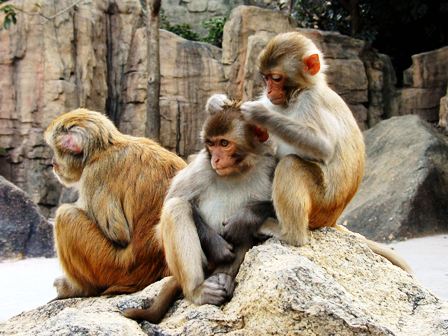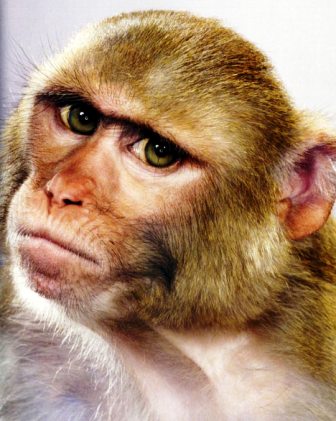Discover Florida Nature
It's time to explore the natural Florida


|
|
|
|
|
 With
an expressive face and active lifestyle, the rhesus macaque, also known
as the Rhesus monkey, is a charismatic species. Its coat is pale brown
above and fades on the underside, but the naked face and rump are bright
red in adults. The rhesus macaque has large cheek pouches which it uses
to store food when foraging. Still widespread across southern Asia, the
rhesus macaque has nevertheless become locally extinct in some of its
former range. It has been introduced into Florida, as well as to Cayo
Santiago Island near Puerto Rico, and is kept in captivity in large
numbers worldwide due to its common use in research. This species has
even been a participant in space travel! With
an expressive face and active lifestyle, the rhesus macaque, also known
as the Rhesus monkey, is a charismatic species. Its coat is pale brown
above and fades on the underside, but the naked face and rump are bright
red in adults. The rhesus macaque has large cheek pouches which it uses
to store food when foraging. Still widespread across southern Asia, the
rhesus macaque has nevertheless become locally extinct in some of its
former range. It has been introduced into Florida, as well as to Cayo
Santiago Island near Puerto Rico, and is kept in captivity in large
numbers worldwide due to its common use in research. This species has
even been a participant in space travel!The Florida population of rhesus macaque gained a foothold niche in the Silver River State Park Local legend has it that the monkeys descended from animals used to film several Tarzan movies nearly 50 years ago at Silver Springs. The first monkeys were brought here at that time, but by a former Jungle Cruise operator who figured that the animals would add an exotic and amusing touch to the lush natural setting. In addition, various colonies of rhesus and other monkey species are speculated to be the result of zoos and wildlife parks destroyed in hurricanes, most notably Hurricane Andrew. The rhesus macaque has a brown body with lighter brown under parts. The monkey's face and rump are red. The average height for females is 18.5 to 20.9 inches, and 19 to 25 inches for males. The average weight for females is approximately 9 to 24 pounds, while males weigh between 12 to 24 lbs. The head is round, the eyes oval, and the ears small. The front legs are longer than the hind legs. Rhesus communities are made up of 10 to 50 individuals of both genders. Males are dominant, but change groups every few years, while females stay associated in a strict matrilineal hierarchy. rhesus macaque are territorial mammals, and will defend its own territory, but subordinate groups usually avoid dominant groups, so physical battle is rare. The rhesus monkey is equally at ease on the ground and in trees (where it sleeps).  Inhabiting
arid, open areas, the Rhesus Macaque may be found in grasslands,
woodlands, and in mountainous regions up to 2,500 meters in elevation.
They are regular swimmers, babies as young as a few days old can swim
and adults are known to swim over a half mile between islands, but are
often found drowned in small groups where their drinking waters lie. The
Rhesus Macaque is noted for its tendency to move from rural to urban
areas, coming to rely on handouts or refuse from humans. It has become a
pest in some areas, perceived as a possible risk to public health and
safety. Inhabiting
arid, open areas, the Rhesus Macaque may be found in grasslands,
woodlands, and in mountainous regions up to 2,500 meters in elevation.
They are regular swimmers, babies as young as a few days old can swim
and adults are known to swim over a half mile between islands, but are
often found drowned in small groups where their drinking waters lie. The
Rhesus Macaque is noted for its tendency to move from rural to urban
areas, coming to rely on handouts or refuse from humans. It has become a
pest in some areas, perceived as a possible risk to public health and
safety.A diurnal animal, the Rhesus Macaque is both arboreal and terrestrial; it is mostly herbivorous and feeds on leaves and pine needles, roots, and the occasional insect or small animal. The monkey has specialized pouch-like cheeks, allowing it to temporarily hoard its food. The gathered morsels are eaten sometime later, in safe surroundings. The average age for sexual maturity is 3.5 to 4 years old. The rhesus macaque gives birth to a single offspring. During estrus the buttocks and the back of the legs deepen in red color for the female. During the mating season the male's buttocks and back of the legs also turn bright red. Females give birth every 12 to 24 months, with a gestation period of 5 to 6 months. These macaques live up to 29 years of age. The Rhesus Macaque is well known to science owing to its relatively easy upkeep in captivity, and has been used extensively in medical and biological research. It has given its name to the Rhesus factor, one of the elements of a person's blood group, by the discoverers of the factor, Karl Landsteiner and Alexander Wiener. The Rhesus Macaque was also used in the well-known experiments on maternal deprivation carried out in the 1950s by comparative psychologist Harry Harlow. |
|
|
Advertise | Privacy Statement | Dog Encyclopedia | Video |Contact | Alaska Nature |
|